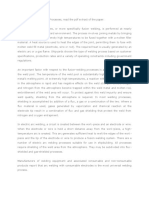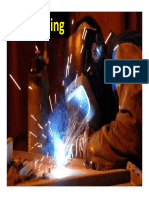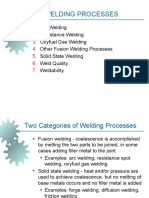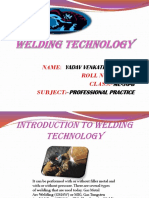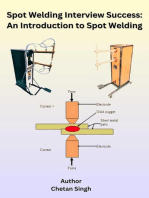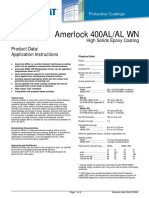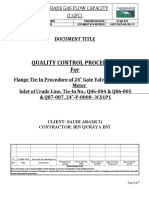0 ratings0% found this document useful (0 votes)
48 viewsCommon Welding Process
Common Welding Process
Uploaded by
Lalit Bom MallaThe document discusses three welding processes:
1) Shielded Metal Arc Welding (SMAW), also known as manual metal arc welding (MMAW), which uses a consumable electrode covered in flux to shield the weld area. It is a versatile process suitable for many applications.
2) Flux-Cored Arc Welding (FCAW), which uses a tubular wire electrode containing flux. It has a high deposition rate but can be prone to porosity.
3) Gas Tungsten Arc Welding (GTAW), also called TIG welding, which uses a non-consumable tungsten electrode and an inert gas shield. It allows for high quality welds but is
Copyright:
© All Rights Reserved
Available Formats
Download as DOCX, PDF, TXT or read online from Scribd
Common Welding Process
Common Welding Process
Uploaded by
Lalit Bom Malla0 ratings0% found this document useful (0 votes)
48 views4 pagesThe document discusses three welding processes:
1) Shielded Metal Arc Welding (SMAW), also known as manual metal arc welding (MMAW), which uses a consumable electrode covered in flux to shield the weld area. It is a versatile process suitable for many applications.
2) Flux-Cored Arc Welding (FCAW), which uses a tubular wire electrode containing flux. It has a high deposition rate but can be prone to porosity.
3) Gas Tungsten Arc Welding (GTAW), also called TIG welding, which uses a non-consumable tungsten electrode and an inert gas shield. It allows for high quality welds but is
Original Description:
Welding
Copyright
© © All Rights Reserved
Available Formats
DOCX, PDF, TXT or read online from Scribd
Share this document
Did you find this document useful?
Is this content inappropriate?
The document discusses three welding processes:
1) Shielded Metal Arc Welding (SMAW), also known as manual metal arc welding (MMAW), which uses a consumable electrode covered in flux to shield the weld area. It is a versatile process suitable for many applications.
2) Flux-Cored Arc Welding (FCAW), which uses a tubular wire electrode containing flux. It has a high deposition rate but can be prone to porosity.
3) Gas Tungsten Arc Welding (GTAW), also called TIG welding, which uses a non-consumable tungsten electrode and an inert gas shield. It allows for high quality welds but is
Copyright:
© All Rights Reserved
Available Formats
Download as DOCX, PDF, TXT or read online from Scribd
Download as docx, pdf, or txt
0 ratings0% found this document useful (0 votes)
48 views4 pagesCommon Welding Process
Common Welding Process
Uploaded by
Lalit Bom MallaThe document discusses three welding processes:
1) Shielded Metal Arc Welding (SMAW), also known as manual metal arc welding (MMAW), which uses a consumable electrode covered in flux to shield the weld area. It is a versatile process suitable for many applications.
2) Flux-Cored Arc Welding (FCAW), which uses a tubular wire electrode containing flux. It has a high deposition rate but can be prone to porosity.
3) Gas Tungsten Arc Welding (GTAW), also called TIG welding, which uses a non-consumable tungsten electrode and an inert gas shield. It allows for high quality welds but is
Copyright:
© All Rights Reserved
Available Formats
Download as DOCX, PDF, TXT or read online from Scribd
Download as docx, pdf, or txt
You are on page 1of 4
Welding Process for Steel Structure Welding
Shielded Metal Arc Welding (SMAW)
Fluxed Cored Arc Welding (FCAW)
Gas Tungsten Arc Welding (GTAW)
MANUAL METAL ARC WELDING
MMAW (Manual Metal Arc welding) or SMAW (Shielded Metal Arc Welding) is:
An arc welding process in with coalescence of metals is produced by heat.
The heat comes from an electric arc that is maintained between the tip of a covered electrode and the surface of the base metal in the
joint being welded.
Always done with a consumable electrode with solid metal sheath and coated in flux to lay the weld.
Striking arc by short cutting.
Can be done inside or at open air.
The consumable electrode provides:
1. Gas protection to shield the arc and prevent atmospheric contamination of the molten filler metal.
2. Adding elements to change the mechanical properties and prevents excessive grain growth in the welded metal.
3. Enhance the mechanical properties and surface cleanliness of the weld metal
As the weld is laid, the flux coating of the electrode evaporates giving off vapors a layer of slag. The flux provides molten slag with
covers the filler metal as it travels from the electrode to the weld pool. Once part of the weld pool is formed, the slag floats to the
surface and protects the weld from atmospheric contamination as it solidifies. Once hardened, it should be chipped away to reveal the
finished weld.
During welding the current remains constant, even if the arc distance and voltage change. The MMAW machines have static dropping
characteristic.
Applications:
Maintenance and repair industries.
Construction of steel structures;
Weld carbon steel, low and high alloy steel, stainless steels, cast iron
Advantages:
Equipment cheap, versatile, simple and portable.
Welds any position.
Disadvantages:
Smokes prejudicial to health. Electrode type choice is crucial.
Need to remove slag immediately due inclusions problems.
Quality depends upon welder skill.
Fig-1.1: Shielded Metal Arc Welding
FLUX CORED ARC WELDING
General Description
Flux Cored Arc Welding (FCAW) is a welding process by fusion which is widely used on ferrous metal. The consumable electrode can
have an interior flux or a mix of flux and metal powder and has a tubular form. Its an easily automated process that is particularly
interesting in highdeposition rate processes.
Energy Source
FCAW has as its energy source an electrical arc that occurs between the fluxed cored wire and base metal in order to melt consumable
electrode and base metal.
Welding Zone Protection
Welding zone protection from atmosphere contamination is assured by the products in the electrodes flux (self shielded flux
cored arc welding) and sometimes by additional gaseous protection (gas shielded flux cored arc welding). The slag created by the flux
gives an additional protection during cooling time but has to be removed after that.
Equipment
FCAW uses a constant voltage welding machine and the process can use DCEP or DCEN polarity. For gas shielded flux cored arc
welding, a cylinder gas is required.
Advantages Disadvantages
A high-deposition rate process.
Irregular wire feed
High energy rates allow greater penetration and a l ower number
of melting defects.
Porosity when the gases (specifically those from the flux-
core) escape the welded area before the metal hardens,
leaving holes in the welded metal
Metallurgical benefits from the flux such as the weld metal being
protected initially from external factors until the flux is chipped
away.
More costly filler material/wire as compared to GMAW
It's an "all-position" process. Less suitable for applications that require painting.
No shielding gas needed making it suitable outdoor welding
andlor windy conditions.
for
Slag removal spending time
High operator skill is required
Safety
FCAW require adequate ventilation and the use of a sealed mask that will provide the welder with fresh air. Also eyes and skin should be
protected by appropriate goggles and clothes.
Fig-1.2: Fluxed Cored Arc Welding
GAS TUNGSTEN ARC WELDING
Gas Tungsten Arc Welding (GTAW), also known as Tungsten Inert Gas (TIG) welding, is a welding process that uses a non-
consumable tungsten electrode to produce the weld. The weld area is protected from atmospheric contamination by an inert shielding gas
(argon or helium), and a filler metal is normally used, though some welds, known as autogenous welds, do not require it. A constant-
current welding power produces energy which is conducted across the arc through a column of highly ionized gas and metal vapors known
as plasma.
GTAW is most commonly used to weld thin sections of stainless steel and non-ferrous metals such as aluminium, magnesium and
copper alloys. The process grants the operator greater control over the weld than competing processes such as shielded metal arc
welding and gas metal arc welding, allowing for stronger, higher quality welds. However, GTAW is comparatively more complex and
difficult to master, and furthermore, it is significantly slower than most other welding techniques. A related process, plasma arc welding,
uses a slightly different welding torch to create a more focused welding arc and as a result is often automated.
Advantages
Applicable to a very wide range of materials.
Especially good for welding thin sections and delicate work-pieces.
Capable of producing welds of high quality and appearance
Disadvantages
Generally restricted to flat or horizontal welding
Low welding rate
Relatively expensive
Fig-1.3: Gas Tungsten Arc Welding
You might also like
- Types of Electric WeldingDocument7 pagesTypes of Electric WeldingSUKhanNo ratings yet
- Principle of Arc WeldingDocument60 pagesPrinciple of Arc Weldingsamurai7_7788% (8)
- Weld Like a Pro: Beginning to Advanced TechniquesFrom EverandWeld Like a Pro: Beginning to Advanced TechniquesRating: 4.5 out of 5 stars4.5/5 (6)
- WpsDocument6 pagesWpsabhishek198327No ratings yet
- American Wide Flange BeamsDocument5 pagesAmerican Wide Flange BeamsLalit Bom MallaNo ratings yet
- Tesda Multiple ChoiceDocument8 pagesTesda Multiple ChoiceAira Ronquillo71% (7)
- WeldingDocument93 pagesWeldingPradeepNo ratings yet
- Types20of20welding1 091203225849 Phpapp02 140905135330 Phpapp01Document73 pagesTypes20of20welding1 091203225849 Phpapp02 140905135330 Phpapp01Anjali AnjuNo ratings yet
- Arc WeldingDocument42 pagesArc WeldingrkpnakNo ratings yet
- Stick: Arc WeldingDocument4 pagesStick: Arc WeldingmohitshuklamarsNo ratings yet
- Types of WeldingDocument66 pagesTypes of WeldingLee Shi HongNo ratings yet
- Workshop Technology IDocument217 pagesWorkshop Technology IRkrishna ANo ratings yet
- Welding TechnologyDocument26 pagesWelding TechnologyHiren Kumar100% (1)
- CWI Module 3Document2 pagesCWI Module 3Basil M. Ikhleif100% (1)
- Welding Process in Steel Construction FieldDocument55 pagesWelding Process in Steel Construction Fieldkevin desaiNo ratings yet
- Shipyard Welding ProcessesDocument6 pagesShipyard Welding ProcessesPawan KumarNo ratings yet
- Welding ProcessDocument42 pagesWelding ProcessPankaj KumbhareNo ratings yet
- Welding TechnologyDocument114 pagesWelding Technologynagarajan224No ratings yet
- Welding 1Document115 pagesWelding 1Shanky BhatnagarNo ratings yet
- ARC WeldingDocument115 pagesARC WeldingRajesh Routray100% (4)
- WeldingDocument14 pagesWeldingarmanimamsNo ratings yet
- Welding: Philippine Society of Mechanical Engineers Professional Development CourseDocument30 pagesWelding: Philippine Society of Mechanical Engineers Professional Development CourseAngel Silva VicenteNo ratings yet
- Shielded Metal Arc Welding (SMAW)Document141 pagesShielded Metal Arc Welding (SMAW)kramNo ratings yet
- Welding Process & DefectsDocument11 pagesWelding Process & DefectsAbhishek TalujaNo ratings yet
- Welding ProcessesDocument77 pagesWelding ProcessesRahul75% (4)
- L2-Arc - Welding - Process - PPTX Filename UTF-8''L2-Arc Welding ProcessDocument18 pagesL2-Arc - Welding - Process - PPTX Filename UTF-8''L2-Arc Welding Process222-020-651No ratings yet
- Types WeldingDocument66 pagesTypes WeldingRathnakraja50% (2)
- Arc WeldingDocument26 pagesArc WeldingAkshay PadekarNo ratings yet
- Welding - Joining ProcessDocument22 pagesWelding - Joining Processnafiz 3265No ratings yet
- Welding (WorkShop) Assig # 1Document7 pagesWelding (WorkShop) Assig # 1Muhammad Talha ZaroonNo ratings yet
- Class - 5 - Baics of Arc WeldingDocument43 pagesClass - 5 - Baics of Arc WeldingroshanpateliaNo ratings yet
- Electric WeldingDocument28 pagesElectric WeldingmayankNo ratings yet
- Welding Notes 0Document70 pagesWelding Notes 0Azmeer Mohamed100% (1)
- 3 Unit 2 - Arc, Gas, Plastic Welding, LBW, EBW and Thermit WeldingDocument96 pages3 Unit 2 - Arc, Gas, Plastic Welding, LBW, EBW and Thermit WeldingAditya KumarNo ratings yet
- Welding BasicsDocument37 pagesWelding BasicsSnehal DeshmukhNo ratings yet
- Welding Lect 2Document41 pagesWelding Lect 2e22mecu0009No ratings yet
- Weilding TechnologyDocument15 pagesWeilding TechnologyRAMALAKSHMI SUDALAIKANNANNo ratings yet
- Quiz Test No DrieDocument17 pagesQuiz Test No Drieapurva karleNo ratings yet
- 4 5816871528360313106 PDFDocument114 pages4 5816871528360313106 PDFAsif AhmedNo ratings yet
- Welding and Cutting ProcessDocument60 pagesWelding and Cutting Processquiron2010100% (1)
- Lectures 7-10Document59 pagesLectures 7-10ranasb.2005No ratings yet
- Arc Welding Process: Michigan Occupational Safety & Health Administration Consultation Education & Training DivisionDocument10 pagesArc Welding Process: Michigan Occupational Safety & Health Administration Consultation Education & Training DivisionNamdeo YengadeNo ratings yet
- WeldingDocument21 pagesWeldingsatishNo ratings yet
- Advanced Welding Process (Welding)Document58 pagesAdvanced Welding Process (Welding)Sk SamsuddinNo ratings yet
- Welding MP-IDocument28 pagesWelding MP-IPIYUSH SHARMANo ratings yet
- UnitDocument41 pagesUnitsawravkblNo ratings yet
- ARC WELDING IN FMT1Document14 pagesARC WELDING IN FMT1Gerardo AgunatNo ratings yet
- MRT-10-2 Arc Welding Principle and SSWDocument27 pagesMRT-10-2 Arc Welding Principle and SSW1026Aniket TankNo ratings yet
- API 577 Key Points - Chapter 5Document4 pagesAPI 577 Key Points - Chapter 5muhammadazharNo ratings yet
- CH 2Document133 pagesCH 2hailayNo ratings yet
- Module 3a - Welding ProcessesDocument36 pagesModule 3a - Welding ProcessesMayur PatelNo ratings yet
- Welding Types Procedures ParametersDocument156 pagesWelding Types Procedures ParametersVinodh Kumar Yalla100% (2)
- Arc WeldingDocument23 pagesArc WeldingZerohumidity 123100% (1)
- Arc Welding Processes w3Document73 pagesArc Welding Processes w3snananrNo ratings yet
- Arc Welding-2016Document7 pagesArc Welding-2016nickNo ratings yet
- Section 8 - Arc Equipment & Processes266 - 27344Document36 pagesSection 8 - Arc Equipment & Processes266 - 27344dbircs2010No ratings yet
- Processes of WeldingDocument9 pagesProcesses of WeldingNaeemNo ratings yet
- Welding NPTEL Lecturers - Part4Document30 pagesWelding NPTEL Lecturers - Part4Sai ChaithanyaNo ratings yet
- Welding Terminology: A Guide to MIG, TIG, Stick, Gas, and Spot Welding TermsFrom EverandWelding Terminology: A Guide to MIG, TIG, Stick, Gas, and Spot Welding TermsNo ratings yet
- Spot Welding Interview Success: An Introduction to Spot WeldingFrom EverandSpot Welding Interview Success: An Introduction to Spot WeldingNo ratings yet
- Amerlock 400CDocument4 pagesAmerlock 400CLalit Bom MallaNo ratings yet
- Pins & Keys: Spring Cotters of A Bolt - Steel Zinc Plated, Yellow PassivatedDocument1 pagePins & Keys: Spring Cotters of A Bolt - Steel Zinc Plated, Yellow PassivatedLalit Bom MallaNo ratings yet
- Amercoat 400AL PDFDocument4 pagesAmercoat 400AL PDFLalit Bom MallaNo ratings yet
- Ameron PN220GDocument4 pagesAmeron PN220GLalit Bom MallaNo ratings yet
- ASME U & R Certification CostDocument2 pagesASME U & R Certification CostLalit Bom Malla0% (1)
- Incident Report FormDocument9 pagesIncident Report FormLalit Bom MallaNo ratings yet
- Comparison Between Astm A 36 and Astm A 283 Grade C 1. Material ScopeDocument1 pageComparison Between Astm A 36 and Astm A 283 Grade C 1. Material ScopeLalit Bom MallaNo ratings yet
- Asme Section II A Sa-283 Sa-283mDocument4 pagesAsme Section II A Sa-283 Sa-283mAnonymous GhPzn1xNo ratings yet
- Closure Questionnaire: Yoke Type 8" 3 00Document1 pageClosure Questionnaire: Yoke Type 8" 3 00Lalit Bom MallaNo ratings yet
- CSWIP Vision Certificate FormDocument1 pageCSWIP Vision Certificate FormLalit Bom MallaNo ratings yet
- Welders Continuity Log: Name Welder ID PMI Job # Gtaw SmawDocument3 pagesWelders Continuity Log: Name Welder ID PMI Job # Gtaw SmawLalit Bom MallaNo ratings yet
- American Wide Flange Beams WDocument7 pagesAmerican Wide Flange Beams WLalit Bom MallaNo ratings yet
- Untitled 1Document1 pageUntitled 1Lalit Bom MallaNo ratings yet
- Ua Welding Continuity Form: Welder/Brazer Continuity InformationDocument1 pageUa Welding Continuity Form: Welder/Brazer Continuity InformationLalit Bom MallaNo ratings yet
- Weld Acceptance StandardDocument2 pagesWeld Acceptance StandardLalit Bom Malla100% (2)
- Importance of NDTDocument10 pagesImportance of NDTLalit Bom MallaNo ratings yet
- Guia Calibracion TofdDocument47 pagesGuia Calibracion Tofdinspeccion_179116669100% (2)
- 1 Catalogue A (Ashoka Profile)Document22 pages1 Catalogue A (Ashoka Profile)fanusNo ratings yet
- Material Properties Requirements For Metallic MaterialsDocument70 pagesMaterial Properties Requirements For Metallic Materialsعزت عبد المنعمNo ratings yet
- Standard Practice For Ultrasonic Thickness TestingDocument1,522 pagesStandard Practice For Ultrasonic Thickness Testingjar_2100% (8)
- Manlift 60-34 PDFDocument2 pagesManlift 60-34 PDFvpizarro_23No ratings yet
- Rules For Classification and Construction VI Additional Rules and GuidelinesDocument20 pagesRules For Classification and Construction VI Additional Rules and Guidelinesrahulchitrakoot123No ratings yet
- Welding Consumables For Steels With Yield Strength 460MPa PDFDocument75 pagesWelding Consumables For Steels With Yield Strength 460MPa PDFali509No ratings yet
- ASTM A416-A416M 17a - Steel StrandDocument5 pagesASTM A416-A416M 17a - Steel StrandEfrain SueldoNo ratings yet
- Competency Profile (CP)Document9 pagesCompetency Profile (CP)nizam1372No ratings yet
- S404502R02 - Conveyors With Magnetic Vibrators - EngDocument28 pagesS404502R02 - Conveyors With Magnetic Vibrators - EngRamon LeoneNo ratings yet
- 6 Bulkhead Connection To Lower and Upper StoolDocument9 pages6 Bulkhead Connection To Lower and Upper StoolHakan özNo ratings yet
- Adani Summer Intern ReportDocument93 pagesAdani Summer Intern Reportgaurav sukhariaNo ratings yet
- Mechanical Projects _ 1000 ProjectsDocument2 pagesMechanical Projects _ 1000 Projectser.rkc91No ratings yet
- Mmaw & GmawDocument54 pagesMmaw & GmawSelvakumaran DhandapaniNo ratings yet
- Apoyos TeflonDocument14 pagesApoyos Teflonjulio1114No ratings yet
- HIA SDC - An OverviewDocument42 pagesHIA SDC - An OverviewGanesan PalaniNo ratings yet
- Pipe JigDocument8 pagesPipe JigVVan TanNo ratings yet
- Casting Forming & Casting, Forming &: Welding WeldingDocument25 pagesCasting Forming & Casting, Forming &: Welding WeldingJordArt GRNo ratings yet
- REPORT RT SERCO 2 DESEMBER 24 ( TAHURA 5,6, M BD1 )Document4 pagesREPORT RT SERCO 2 DESEMBER 24 ( TAHURA 5,6, M BD1 )Ferdie OSNo ratings yet
- Section 28: Landscaping 03: Play EquipmentDocument4 pagesSection 28: Landscaping 03: Play EquipmentJaijeev PaliNo ratings yet
- UGFC-PQCP-49, Rev01 March 01Document7 pagesUGFC-PQCP-49, Rev01 March 01Mahaboob PashaNo ratings yet
- Arc BlowDocument8 pagesArc BlowAnonymous 4e7GNjzGWNo ratings yet
- 3905 - Engl - 2012 - 11 KTADocument61 pages3905 - Engl - 2012 - 11 KTAkartoon_38No ratings yet
- Chinese Business Guide The Name Lists of Some Chinese Machinery EnterprisesDocument159 pagesChinese Business Guide The Name Lists of Some Chinese Machinery EnterprisesNorm SaiNo ratings yet
- Penawaran Mesin LasDocument3 pagesPenawaran Mesin LasPT MITRA BERSAMA TEKNIKANo ratings yet
- PUB145Document133 pagesPUB145Eithne FajardoNo ratings yet
- Sajid Curriculum VitaeDocument2 pagesSajid Curriculum VitaeMoinNo ratings yet
- Oxyfuel Gas Welding (OFW) : ©2010 John Wiley & Sons, Inc. M P GrooverDocument12 pagesOxyfuel Gas Welding (OFW) : ©2010 John Wiley & Sons, Inc. M P GrooverMr-Mk MughalNo ratings yet
- ME 322-Manufacturing Processes IDocument2 pagesME 322-Manufacturing Processes Ifirsttenor100% (1)















